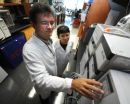(Press-News.org) Knowing the position of missing oxygen atoms could be the key to cheaper solid oxide fuel cells with longer lifetimes. New microscopy research from the Department of Energy's Oak Ridge National Laboratory is enabling scientists to map these vacancies at an atomic scale.
Although fuel cells hold promise as an efficient energy conversion technology, they have yet to reach mainstream markets because of their high price tag and limited lifespans. Overcoming these barriers requires a fundamental understanding of fuel cells, which produce electricity through a chemical reaction between oxygen and a fuel. As conducting oxygen ions move through the fuel cell, they travel through vacancies where oxygen atoms used to be. The distribution, arrangement and geometry of such oxygen vacancies in fuel cell materials are thought to affect the efficiency of the overall device.
"A big part of making a better fuel cell is to understand what the oxygen vacancies do inside the material: how fast they move, how they order, how they interact with interfaces and defects," said ORNL's Albina Borisevich. "The question is how to study them. It's one thing to see an atom of one type on the background of atoms of a different type. But in this case, you want to see if there are a few atoms missing. Seeing a void is much more difficult."
In research published in Nature Materials, ORNL scientists used scanning transmission electron microscopy to determine the distribution of oxygen vacancies in a fuel cell cathode material below the level of a single unit cell. The team verified its findings with theoretical calculations and neutron experiments at the lab's Spallation Neutron Source.
"Even though the vacancy doesn't generate any signal in the electron micrograph, it's still a big disturbance in the structure," Borisevich said. "You can see that the lattice expands where vacancies are present. So we tracked the lattice expansion around vacancies and compared it with theoretical models, and we were able to develop a calibration for this type of material."
By providing a means to study vacancies at an atomic scale, the ORNL technique will help inform the development of improved fuel cell technologies in a systematic and deliberate fashion, in contrast to trial and error approaches.
Beyond its relevance to applications in fuel cells and information storage and logic devices, ORNL coauthor Sergei Kalinin explains that the team's research is also building a bridge between two scientific communities that traditionally have had little in common.
"From my perspective, it is physics marrying electrochemistry," Kalinin said. "The idea is that vacancies are important for energy, and vacancies are important for physics. The materials that physicists like to study are exactly the same as the materials used for fuel cells, and unless we understand how vacancies behave at interfaces, ferroic domain walls, and in thin films, we will not be able to fully appreciate the physics of these systems."
The team's research is also reinforced by a parallel study published in Physical Review Letters, with Borisevich and Kalinin as coauthors, that explains how to obtain parameters that describe vacancy-ordered systems from electron microscopy data.
INFORMATION:
Coauthors on the Nature Materials paper are ORNL's Young-Min Kim, Jun He, Michael Biegalski, Hailemariam Ambaye, Valerie Lauter, Hans Christen, and Stephen Pennycook; and Vanderbilt University's Sokrates Pantelides. The work was supported by the U.S. Department of Energy, Office of Science. Portions of this research were conducted at the Center for Nanophase Materials Sciences and the Spallation Neutron Source, which are both also sponsored at ORNL by DOE's Office of Science.
ORNL is managed by UT-Battelle for the Department of Energy's Office of Science. DOE's Office of Science is the single largest supporter of basic research in the physical sciences in the United States, and is working to address some of the most pressing challenges of our time. For more information, please visit http://science.energy.gov.
END
Augusta, GA—Researchers at the Georgia Health Sciences University Cancer Center have identified a gene that disrupts the inflammatory process implicated in liver cancer.
Laboratory mice bred without the gene lacked a pro-inflammatory protein called TREM-1 and protected them from developing liver cancer after exposure to carcinogens.
The study, published in Cancer Research, a journal for the American Association for Cancer Research, could lead to drug therapies to target TREM-1, said Dr. Anatolij Horuzsko, an immunologist at the GHSU Cancer Center and principal investigator ...
Washington, D.C.—Carnegie scientists are the first to discover the conditions under which nickel oxide can turn into an electricity-conducting metal. Nickel oxide is one of the first compounds to be studied for its electronic properties, but until now scientists have not been able to induce a metallic state. The compound becomes metallic at enormous pressures of 2.4 million times the atmospheric pressure (240 gigapascals). The finding is published in Physical Review Letters.
"Physicists have predicted for decades that the nickel oxide would transition from an insulator—a ...
Northwestern University scientists have connected 250 years of organic chemical knowledge into one giant computer network -- a chemical Google on steroids. This "immortal chemist" will never retire and take away its knowledge but instead will continue to learn, grow and share.
A decade in the making, the software optimizes syntheses of drug molecules and other important compounds, combines long (and expensive) syntheses of compounds into shorter and more economical routes and identifies suspicious chemical recipes that could lead to chemical weapons.
"I realized that ...
Enzymes involved in breaking down fat can now be manipulated to work three times harder by turning on a molecular switch recently observed by chemists at the University of Copenhagen. Being able to control this chemical on/off button could have massive implications for curing diseases related to obesity including diabetes, cardio vascular disease, stroke and even skin problems like acne. But the implications may be wider.
The results suggest that the switch may be a common characteristic of many more enzymes. Since enzymes are miniscule worker-molecules that control a ...
AUDIO:
This is a gibbon call without helium.
Click here for more information.
Have you ever heard an opera singing ape? Researchers in Japan have discovered that singing gibbons use the same vocal techniques as professional soprano singers. The study, published in the American Journal of Physical Anthropology, explains how recording gibbons singing under the influence of helium gas reveals a physiological similarity to human voices.
The research was led by Dr Takeshi Nishimura ...
Philadelphia, PA, August 23, 2012 – The routine use of prostate specific antigen (PSA) testing for screening and monitoring prostate cancer has led to early and more sensitive detection of the disease. A new study published in The Journal of Urology® reports that in the "PSA era," survival has improved for patients with newly diagnosed prostate cancer that has spread to the bones or other parts of the body and the disparity between African American and Caucasian men has been resolved.
"Our analysis indicates an overall improvement in risk adjusted survival rates for ...
Reducing tillage for some Central Great Plains crops could help conserve water and reduce losses caused by climate change, according to studies at the U.S. Department of Agriculture (USDA).
Research leader Laj Ahuja and others at the Agricultural Research Service (ARS) Agricultural Systems Research Unit at Fort Collins, Colo., superimposed climate projections onto 15 to 17 years of field data to see how future crop yields might be affected. ARS is USDA's chief intramural scientific research agency, and this work supports the USDA priority of responding to climate change.
The ...
To celebrate the upcoming birth of Adele's first child, Womensforum.com is launching a Facebook contest asking her legions of fans to guess what the Grammy Award-winning singer Adele will name her first baby.
Any entrant correctly guessing the baby's name gets a shot at winning a trip for two to Adele's hometown of London, England! The winning package includes round trip air fare for two and four nights in a luxury London hotel.
As a bonus, entrants who invite three or more friends to participate have a chance to win one of three Apple iPod Nano's loaded with Adele's ...
Capitol Lighting, a leading retailer of light and ceiling fan fixtures with eight lighting stores in New Jersey and Florida and worldwide at http://www.1-800Lighting.com announces Chapter 2 of the Social Media Boot Camp Webinar Series on Tuesday, August 28, 2012
Along with Hubbardton Forge, Capitol Lighting stores will be hosting the webinar to help lighting professionals understand how they can best use social media to grow their business. Topics to be covered in the webinar include:
Why is it important to use LinkedIn and who uses it?
How do I get started?
...
Vampire Labs, LLC, an innovative company developing technologies aimed at eliminating wasted energy, announced today that it has been awarded United States Patent No. 8,232,775 for its novel approach to eliminating vampire energy loss (also known as vampire power) in consumer electronics.
The patent, which falls under the company's Vampire Proof technology portfolio, addresses the nearly 500 billion energy-wasting electronic devices sold worldwide each year. It eliminates the energy that is continuously consumed and wasted by mobile devices when they are plugged into ...

